The Transformation of a Religious Landscape : Medieval Southern Italy, 850–1150 / Valerie Ramseyer.
Material type: TextSeries: Conjunctions of Religion and Power in the Medieval PastPublisher: Ithaca, NY : Cornell University Press, [2006]Copyright date: ©2015Description: 1 online resource (248 p.) : 3 charts/graphs, 5 mapsContent type:
TextSeries: Conjunctions of Religion and Power in the Medieval PastPublisher: Ithaca, NY : Cornell University Press, [2006]Copyright date: ©2015Description: 1 online resource (248 p.) : 3 charts/graphs, 5 mapsContent type: - 9781501702280
- 274.5/7403
- BX1546
- online - DeGruyter
| Item type | Current library | Call number | URL | Status | Notes | Barcode | |
|---|---|---|---|---|---|---|---|
 eBook
eBook
|
Biblioteca "Angelicum" Pont. Univ. S.Tommaso d'Aquino Nuvola online | online - DeGruyter (Browse shelf(Opens below)) | Online access | Not for loan (Accesso limitato) | Accesso per gli utenti autorizzati / Access for authorized users | (dgr)9781501702280 |
Frontmatter -- Contents -- Maps -- Genealogies -- Abbreviations -- The Archives of the Abbey of the Holy Trinity of Cava -- Acknowledgments -- Introduction -- Part I. Christianity in the Lombard Era (c. 849–1077) -- Chapter 1. Society and Government before the Normans -- Chapter 2. Religious Authority and Ecclesiastical Organization before Centralization -- Chapter 3. Religious Houses and the Clergy before Reform -- Part II. Reorganization and Reform in the Norman Period (c. 1050–1130) -- Chapter 4. The New Archbishopric of Salerno -- Chapter 5. The Construction of a Monastic Lordship: The Abbey of the Holy Trinity of Cava -- Epilogue: Changes and Continuities -- Works Cited -- Index
restricted access online access with authorization star
http://purl.org/coar/access_right/c_16ec
The Transformation of a Religious Landscape paints a detailed picture of the sheer variety of early medieval Christian practice and organization, as well as the diverse modes in which church reform manifested itself in the eleventh and twelfth centuries.From the rich archives of the abbey of the Holy Trinity of Cava, Valerie Ramseyer reconstructed the complex religious history of southern Italy. No single religious or political figure claimed authority in the region before the eleventh century, and pastoral care was provided by a wide variety of small religious houses. The line between the secular and the regular clergy was not well pronounced, nor was the boundary between the clergy and the laity or between eastern and western religious practices. In the second half of the eleventh century, however, the archbishop of Salerno and the powerful abbey of Cava acted to transform the situation. Centralized and hierarchical ecclesiastical structures took shape, and an effort was made to standardize religious practices along the lines espoused by reform popes such as Leo IX and Gregory VII. Yet prelates in southern Italy did not accept all aspects of the reform program emanating from centers such as Rome and Cluny, and the region's religious life continued to differ in many respects from that in Francia: priests continued to marry and have children, laypeople to found and administer churches, and Greek clerics and religious practices to coexist with those sanctioned by Rome.
Mode of access: Internet via World Wide Web.
In English.
Description based on online resource; title from PDF title page (publisher's Web site, viewed 26. Apr 2024)


